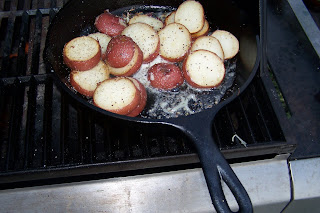
Not only has it been nearly a year since my last post (far too long I know) but it has been just over 19 months since I began the process of curing my very first ham...and definitely not the last. It is true that I would have taken the ham down much sooner had it not been for pure laziness and the knowledge that the longer it stayed up there the better it would get.
In December of 2007 I purchased a hog from
Long Family Farms which is located just outside of Eaton, CO (my hometown). The ham weighed in at 25 pounds. To begin the process per the instruction of two experts,
Michael Ruhlman and
Brian Polcyn, I coated the ham completely with kosher salt on a half sheet pan for about 35 days. Every couple of days I took it out of the fridge to drain the water off and redistribute the salt as necessary. Sometime in late January I rinsed the ham off, rubbed it with fresh lard (from the same hog) and coated it with black peppercorns. With a wrap of cheesecloth and a bike hook in my garage, the journey began.
Because this process was new to me and the Colorado climate is not exactly prime for curing hams (a bit too hot and dry in the summer, cold and dry in the winter) I was slightly concerned that it would be a very long science experiment and a complete waste of 25 pounds of a sublime cut of meat. All concerns, however, were relieved when in early July I cut that ham down with the assistance of my Magyar Brother Gergo and his mother Charlotte. The finished weight of the ham was 15 pounds. As soon as my knife cut into the flesh the intense aroma informed me that all was not lost and I had indeed completed some very strong work. The glistening pink flesh outlined by layers of fat confirmed what my nose had already told me.
If anyone has ever considered curing your own ham, then by all means do it. It is incredibly simple and oh so rewarding. I will soon be posting on the various creations inspired by this ham...my first.
















